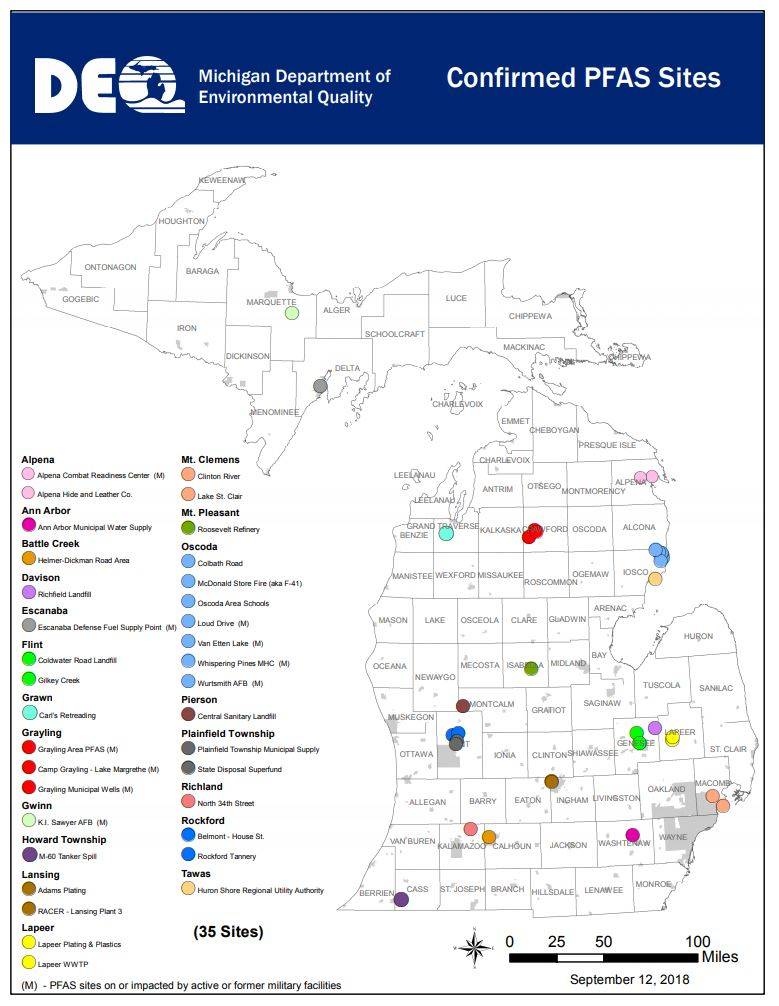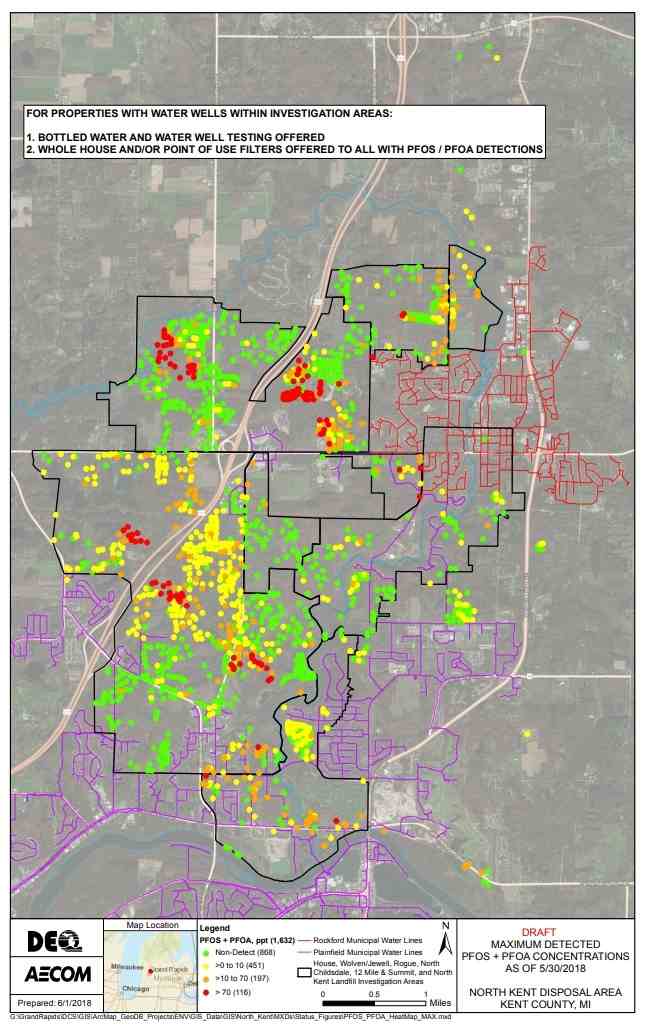PFAS General Information
What is PFAS?
PFAS (Per- and Polyfluoroalkyl Substances) is a class of chemical compounds that include over 3,000 synthetic organic chemicals used since the 1940s that contain multiple Fluorine (F) atoms. The two most studied PFAS compounds are Perfluorooctanoic Acid (PFOA) and Perfluorooctane Sulfonate (PFOS).


PFAS have a wide range of commercial and industrial applications, including: polymers and coatings (Scotchgard®, Teflon®, Gore-Tex®, etc.), fire-fighting foams (AFFF), metal-plating, food packaging, cosmetics, and various other applications.

PFAS in the Environment
Although these chemicals provide beneficial uses to society, there are several human health and environmental challenges due to the creation and use of PFOA and PFOS, including:
- Water Solubility – able to enter into, and spread via, groundwater and surface water with high stability making them resistant to chemical and biological degradation
- Bioaccumulation – concentrations can increase 10,000 times in fish and aquatic organisms
- Binds to proteins in blood and is reabsorbed by the human kidney – stays in circulation and, due to inefficient elimination, has a half-life of 4-9 years
- High maternal transfer to fetus
Select Chemical Properties of PFAS and other Contaminants (PubChem and EPA)
|
Property |
PFOA |
PFOS |
PFBS* |
PCB 1260 |
TCE** |
|---|---|---|---|---|---|
|
Water Solubility 25°C (mg/L) |
9500 |
680 |
344 |
0.0027 |
1100 |
|
Soil Adsorption Factor (Log Koc) |
2.0 |
2.5 |
1.5 |
6 |
2.4 |
|
Bioconcentration Factor (BCF) |
3 |
1000 |
0.71 |
100,000 |
4 |
*Perfluorobutane sulfonate
**Trichloroethylene
How is PFAS measured and reported?
PFAS concentrations are reported in concentrations of “parts per trillion”, or “ppt”. A ppt is a measurement of the quantity of a substance in the air, water, or soil where there is one part of that substance for every one trillion parts of the medium it is contained in (a ratio of 1:1,000,000,000,000). One part per trillion is equivalent to one nanogram per liter of water. A nanogram is a unit of measurement that is equal to one billionth of a gram. One way to visualize this amount is that a dollar bill weighs about 1 gram. To get 1 nanogram, the dollar bill would be cut into 1,000 pieces. Take one of those pieces and cut it into another 1,000 equal pieces. Then take one of those pieces and cut it into another 1,000 pieces. Each piece in this group will be a billionth of the original dollar and will weigh approximately 1 nanogram. Other ways to conceptualize one ppt are one second in 32,000 years or one grain of sand in an Olympic-size swimming pool.
While this concentration appears to be very small, certain hormones and biomolecules have significant effects at this concentration. Examples include:
|
Compound |
Concentration in blood serum (ppt) |
|---|---|
|
Aldosterone – regulates blood pressure |
10-210 |
|
Estradiol – premenopausal female |
15-350 |
|
Parathyroid hormone |
10-65 |
|
Testosterone (free) – male |
90-300 |
|
Corticotropin (ACTH) – pituitary hormone |
10-60 |
|
Triiodothyronine (T3) (free) |
2.4-4.2 |
Health Effects of PFAS
During 2005-2013, the C8 Science Panel carried out exposure and health studies in Mid-Ohio Valley communities, which potentially had been affected by the releases of PFOA (or C8) emitted since the 1950s from the Washington Works plant in Parkersburg, West Virginia. They then assessed the links between C8 exposure and a number of diseases. The C8 Science Panel has completed its work and no longer exists; this website summarizes the results.
The Science Panel consisted of three epidemiologists: Tony Fletcher, David Savitz, and Kyle Steenland, who were chosen jointly by the parties to the legal settlement of a case between plaintiffs and DuPont regarding releases of C8 from the plant. The Panel, its research program, and links to other sources of information can be found via the links below.
The main conclusions are in the form of Probable Link reports which summarize in each case whether the Science Panel found or did not find a link between exposure and disease. The detailed science behind the summaries in the Probable Link reports is published in articles in scientific journals. Many articles have been published and a few more are still in the process of publication. Follow the links below. For six disease categories, the Science Panel concluded that there was a Probable Link to C8 exposure: diagnosed high cholesterol, ulcerative colitis, thyroid disease, testicular cancer, kidney cancer, and pregnancy-induced hypertension.
The Environmental Protection Agency has recommended a lifetime exposure guideline for PFOS+PFOA of 70 ng/l (ppt). The state of Michigan has adopted this level as a cleanup standard.
Other states have adopted lower levels based on the desire to protect sensitive populations (fetus, infants)
- New Jersey: 14 ppt PFOA - https://www.nj.gov/dep/watersupply/pdf/pfoa-recommend.pdf
- Minnesota: 35 ppt PFOA and 27 ppt PFAS - https://www.health.state.mn.us/divs/eh/hazardous/topics/pfcs/current.html
- Vermont: 20 ppt PFOA - https://www.healthvermont.gov/environment/drinking-water/perfluoroalkyl-and-polyfluoroalkyl-substances-pfas-drinking-water
PFAS in Michigan
Reports of PFAS contamination in Kent County and elsewhere in Michigan have sparked public interest in the topic. Concerns surrounding PFAS have been persistent for decades, leading to their removal from industrial and commercial use by the early 2000s. However, improper disposal of PFAS and their prevalence in fire-fighting foams has led to issues at numerous sites across Michigan.

Map of MDEQ confirmed PFAS sites throughout the State of Michigan. (Source: https://www.michigan.gov/documents/deq/deq-map-confirmedPFASsites_611932_7.pdf)
Perhaps the most famous contamination site in Michigan, Kent County has witnessed high concentrations of PFAS in drinking waters, resulting from disposal of tannery waste from the Wolverine World Wide facility.

Map of PFAS concentrations at sites in Kent County, MI. (Source: https://www.michigan.gov/documents/pfasresponse/BEL_180601_PFOS_PFOA_HeatMap_MAX_624687_7.pdf)
The disposal site, located at 1855 House Street, was the suspected source of PFAS contamination of drinking water wells in three northern Kent Co. townships. A “Remedial Investigation Work Plan” was proposed by Wolverine World Wide in Nov 2017, under direction of the Michigan Department of Environmental Quality (MDEQ), in an attempt to assess PFAS levels in Kento Co. [link: https://www.michigan.gov/documents/deq/ConceptualSiteModel-RIWP-112717-redacted_607260_7.pdf]. With constant surveillance, installation of point-of-use filtration units, and continuous reporting, Wolverine World Wide continues to work on addressing PFAS contamination in the area [link: https://www.michigan.gov/pfasresponse/0,9038,7-365-86511_82704_83030---,00.html]. Regular updates on this situation can be found below:
- Aug 10, 2018: https://www.michigan.gov/documents/pfasresponse/Memo_to_DEQ_Hendershott_from_RW_Nelson_dated_081018_633568_7.pdf
- June 29, 2018: https://www.michigan.gov/documents/pfasresponse/Letter_to_DEQ_Hendershott_from_RW_Westra_and_Powers_dated_062918_628543_7.pdf
- May 4, 2018: https://www.michigan.gov/documents/deq/Email_to_DEQ_Hendershott_from_www_westra_and_powers_dated_050418_623674_7.pdf
- Feb 9, 2018: ftp://geoportal.wri.gvsu.edu/awri_website/HouseStreetConceptualSiteModel.pdf
Where can I read more about PFAS in Michigan?
Visit our PFAS news archive for links to media coverage at the regional, state, and federal level.
Kent County, MI PFAS Information
- Selected Site Reports (PDFs)
- EGLE Rockford/Belmont Area PFAS website
- EGLE Rockford/Belmont Area PFAS contamination map (Google maps)
- EGLE Rockford/Belmont Area PFAS test results map (PDF)
- Kent County Health Department PFAS website
- Fish Consumption Advisories
- Plainfield Township Annual Water Quality Reports
- Environmental Working Group’s Tap Water Database Plainfield Township
- EPA Wolverine World Wide Tannery website

Metal drums and tannery waste at a former Wolverine World Wide dump site in Belmont, MI, where drinking water has been polluted with PFAS compounds. (Source: https://www.mlive.com/news/grand-rapids/index.ssf/2017/11/varnum_wolverine_lawsuit.html)
State of Michigan PFAS information

